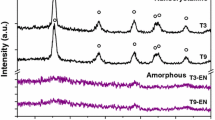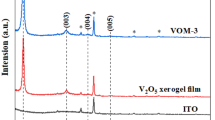Abstract
Here we report on the hydrogen photochromism carried out in the V2O5 xerogels with the use of dimethylformamide (DMF) as a hydrogen donor. The adsorption of DMF was carried out by an original method: DMF was adsorbed on the V2O5 surface along the formation of the xerogel from the sol containing the hydrogen donor. The mechanism of the DMF adsorption on the V2O5 xerogel surface has been discovered by Fourier transform infrared spectroscopy. DMF molecules have been bonded to the oxide surface by donor–acceptor and hydrogen bonds, which pre-determines easy detachment of hydrogen atoms under the action of light. It has been demonstrated that the pronounced hydrogen photocromism can be carried out in the V2O5 xerogels with the use of DMF. The peculiarities of the photochromism have been discussed. The spirit of the research is to provide charging of the V2O5 surface with the hydrogen donor along the formation of the oxide xerogel catalyst.








Similar content being viewed by others
References
Granqvist CG (1995) Handbook of Inorganic Electrochromic Materials. Elsevier, Amsterdam
Talledo A, Granqvist CG (1995) Electrochromic vanadium–pentoxide–based films: Structural, electrochemical, and optical properties. J Appl Phys 77(9):4655–4666
Gavrilyuk A, Tritthart U, Gey W (2011) Photoinjection of hydrogen and the nature of a giant shift of the fundamental absorption edge in highly disordered V2O5 films. Phys Chem Chem Phys 13(20):9490–9497
Gavrilyuk A, Tritthart U, Gey W (2007) Photo-stimulated proton-coupled electron transfer in quasi-amorphous WO3 and MoO3 thin films. Philos Mag 87(29):4519–4553
Gavrilyuk AI (2016) Aging of the nanosized photochromic WO3 films and the role of adsorbed water in the photochromism. Appl Surf Sci 364:498–504
Wang Y, Pan L, Li Y, Gavrilyuk AI (2014) Hydrogen photochromism in V2O5 layers prepared by the sol–gel technology. Appl Surf Sci 314:384–391
Bachmann HG, Ahmed FR, Barnes WH (1961) The crystal structure of vanadium pentoxide. Z für Krist 115(1-6):110–131
Livage J (1991) Vanadium pentoxide gels. Chem Mater 3(4):578–593
Michailovits L, Hevesi I, Phan L, Varga ZS (1983) Determination of the optical constants and thickness of amorphous V2O5 thin films. Thin Solid Films 102(1):71–76
Livage J, Lucazeau G (1982) Infrared and Raman study of amorphous V2O5. J Raman Spectrosc 12(1):68–72
Clark RJH (1968) The chemistry of titanium and vanadium. Elsevier, Amsterdam
Julien C, Nazri GA, Bergström O (1997) Raman scattering studies of microcrystalline V6O13 Phys Status Solidi (b) 201(1):319–326
Abello L, Husson E, Repelin Y, Lucazeau G (1983) Vibrational spectra and valence force field of crystalline V2O5 Spectrochim Acta [A] 39(7):641–651
Rougier A, Portemer F, Quede A, Marssi MEL (1999) Characterization of pulsedlaser deposited WO3 thin films for electrochromic devices Appl Surf Sci 153(1):1–9
Gavrilyuk AI (2016) Degradation of dimethylformamide on the surface of the nanosized WO3 films studied by infrared spectroscopy. Appl Surf Sci 377:56–65
Dexter DL (1956) Absorption of light by atoms in solids. Phys Rev 101:48–55
Cukierman S (2006) Et tu Grotthuss! and other unfinished stories. Biochim Biophys Acta 1757:876–878
Agmon N (1995) The Grotthuss mechanism. Chem Phys Lett 244:456–462
Acknowledgements
We thank the National Natural Science Foundation of China (No.51572058, 51502057), the International Science and Technology Cooperation Program of China (2013DFR10630, 2015DFE52770), National Key Research and Development Program (2016YFB0303903), and the Foundation of Science and Technology on Advanced Composites in Special Environment Laboratory.
Author information
Authors and Affiliations
Corresponding author
Ethics declarations
Conflict of interest
The authors declare that they have no conflict of interest.
Additional information
Highlights
-
Dimethylformamide (DMF) was added to the sol containing V2O5 species.
-
When the sol turned into the xerogel, DMF was adsorbed on its surface and the adsorption mechanism was investigated by FTIR spectroscopy.
-
The xerogel V2O5 layers exhibited pronounced hydrogen photochromism and hydrogen atoms were detached under the action of light from the CHO groups of DMF
Electronic supplementary material
Rights and permissions
About this article
Cite this article
Wang, Y., Lee, Y., Jhao, J. et al. Hydrogen photochromism in V2O5 layers prepared by sol–gel technology with the use of dimethylformamide as a hydrogen donor. J Sol-Gel Sci Technol 86, 126–134 (2018). https://doi.org/10.1007/s10971-018-4614-1
Received:
Accepted:
Published:
Issue Date:
DOI: https://doi.org/10.1007/s10971-018-4614-1




